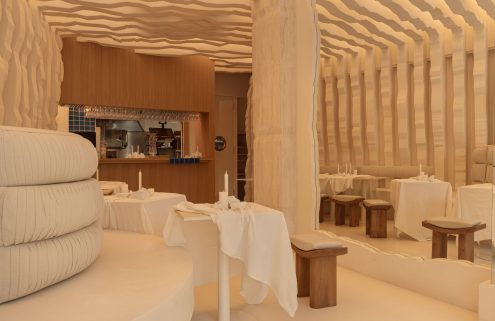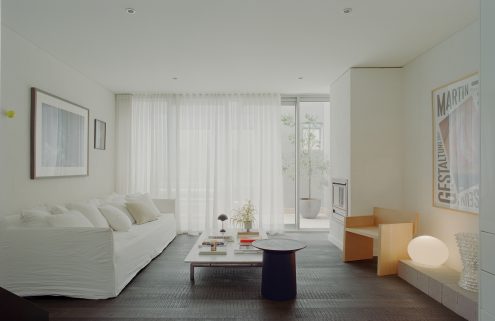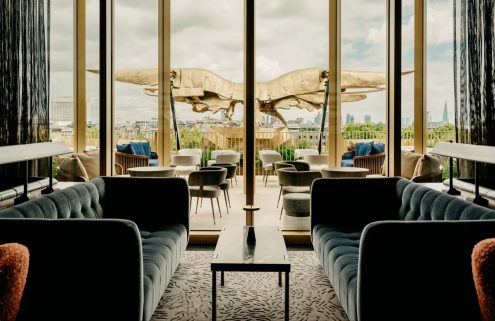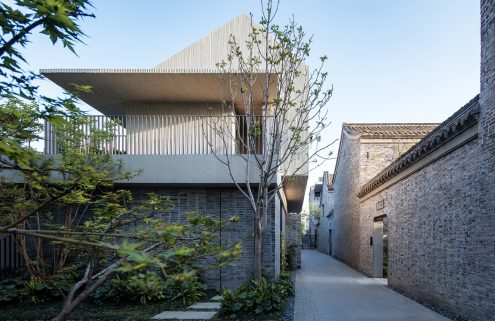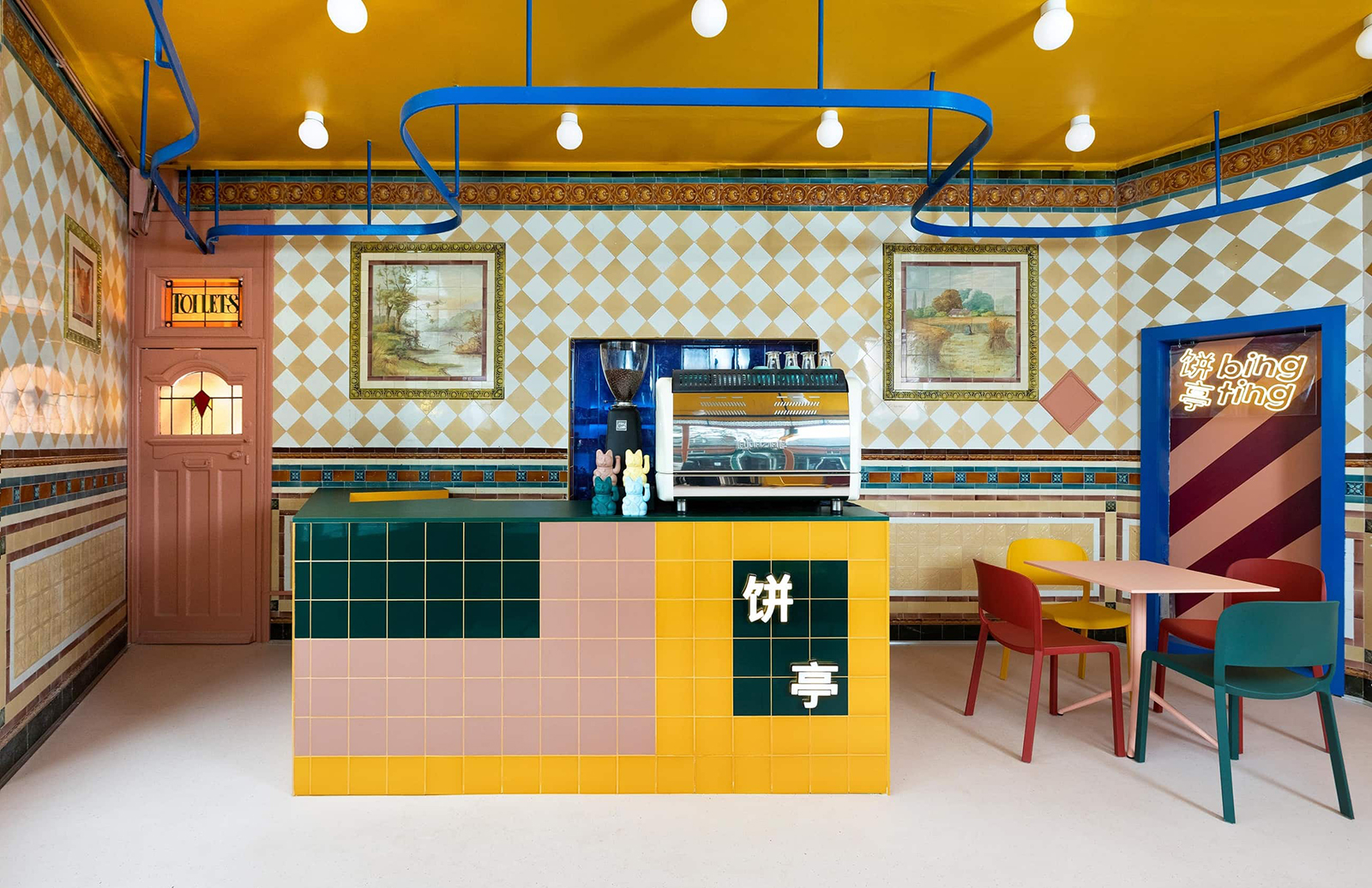We’ve featured lots of remarkable conversions over the years, but this Kington Upon Hull restaurant by Studio Sam Buckley proves that less is more, if you really want to go all out…
The Bing Ting Cafe takes over a 19th-century butcher’s shop, complete with original, ornate wall and floor tiles – all of which are historically listed and can’t be altered. Buckley leans into this pre-existing fabric to shape his innovations, pulling colours from the Victorian tiling and stained glass windows for diamond-shaped tables and jewel-toned chairs.

Ultramarine accents – a snaking lighting rail, door frames and translucent curtain separating the kitchen from the dining room – pop against the yellow ceiling, while the existing floor has been covered in a milky rubber skin by Forbo, preserving the tiles beneath from foot traffic.
Diagonal stripes and neon lights deviate further from the prosaic Victorian murals and the scene for the restaurant’s culinary offerings – Jian Bing pancakes, bubble teas and modern Chinese street food. It’s a very modern design fusion.
63 Princes Ave, Hull HU5 3QX, United Kingdom.




See more historic shop conversions that blend old and new

Converted meat and grocery shop in North London
Handpainted tiles and woodwork point to this London property’s former life as a meat and grocery shop in the 1880s. Formerly known as A. Hancock Butchers, the Grade II-listed North London building has long since hung up its butcher’s apron but the shop’s 19th-century emerald and white tiles are all heritage listed and are on show as the focal point of interventions into the ground floor space.
What was once the store is now a large kitchen, complete with Aga and two marble counters – one on a service station, the other a payment kiosk – and a glazed frieze composed of Art Nouveau tiles. The living room is bathed in milky light from the shop facade, fitted with translucent panes, while the old shop sign still hangs above the entrance to the two-bedroom home. Unsurprisingly, the London property was quickly snapped up when it hit the market via The Modern House but you can still browse its inspiring interiors.
Photography: The Modern House

Converted meat and grocery shop in North London
Handpainted tiles and woodwork point to this London property’s former life as a meat and grocery shop in the 1880s. Formerly known as A. Hancock Butchers, the Grade II-listed North London building has long since hung up its butcher’s apron but the shop’s 19th-century emerald and white tiles are all heritage listed and are on show as the focal point of interventions into the ground floor space.
What was once the store is now a large kitchen, complete with Aga and two marble counters – one on a service station, the other a payment kiosk – and a glazed frieze composed of Art Nouveau tiles. The living room is bathed in milky light from the shop facade, fitted with translucent panes, while the old shop sign still hangs above the entrance to the two-bedroom home. Unsurprisingly, the London property was quickly snapped up when it hit the market via The Modern House but you can still browse its inspiring interiors.
Photography: The Modern House

Converted meat and grocery shop in North London
Handpainted tiles and woodwork point to this London property’s former life as a meat and grocery shop in the 1880s. Formerly known as A. Hancock Butchers, the Grade II-listed North London building has long since hung up its butcher’s apron but the shop’s 19th-century emerald and white tiles are all heritage listed and are on show as the focal point of interventions into the ground floor space.
What was once the store is now a large kitchen, complete with Aga and two marble counters – one on a service station, the other a payment kiosk – and a glazed frieze composed of Art Nouveau tiles. The living room is bathed in milky light from the shop facade, fitted with translucent panes, while the old shop sign still hangs above the entrance to the two-bedroom home. Unsurprisingly, the London property was quickly snapped up when it hit the market via The Modern House but you can still browse its inspiring interiors.
Photography: The Modern House

A 16th-century shop and townhouse in Oxford
If England’s Victorian-era stores were big on porcelain tiles, it seems 16th-century shops were all about oaks and dark woods. In Oxford, a converted shop and townhouse set history-loving hearts aflutter when it went on sale via Inigo last year, with parts of the structure dating from the medieval and Georgian eras. Rooms on the ground floor, where the old shop was located, are outfitted with linenfold panelling (so-called because the squares look like creases of a folded handkerchief) and have the old bay-style windows favoured at the town.
Photography: Inigo

A 16th-century shop and townhouse in Oxford
If England’s Victorian-era stores were big on porcelain tiles, it seems 16th-century shops were all about oaks and dark woods. In Oxford, a converted shop and townhouse set history-loving hearts aflutter when it went on sale via Inigo last year, with parts of the structure dating from the medieval and Georgian eras. Rooms on the ground floor, where the old shop was located, are outfitted with linenfold panelling (so-called because the squares look like creases of a folded handkerchief) and have the old bay-style windows favoured at the town.
Photography: Inigo

A 16th-century shop and townhouse in Oxford
If England’s Victorian-era stores were big on porcelain tiles, it seems 16th-century shops were all about oaks and dark woods. In Oxford, a converted shop and townhouse set history-loving hearts aflutter when it went on sale via Inigo last year, with parts of the structure dating from the medieval and Georgian eras. Rooms on the ground floor, where the old shop was located, are outfitted with linenfold panelling (so-called because the squares look like creases of a folded handkerchief) and have the old bay-style windows favoured at the town.
Photography: Inigo

A converted pie and mash shop in East London
Think of Britain and two culinary delicacies spring to mind: fish and chips, and pie and mash. The latter was sold throughout the 20th century at J Gooding’s Pie and Mash shop in East London before it was converted into a three-bedroom home in 2000. As part of its adaptive reuse, it kept the original tiled interiors, clay floor tiles and the old shop facade, complete with historic signage and frosted glazing.
Photography: Jess Kennedy Photography

A converted pie and mash shop in East London
Think of Britain and two culinary delicacies spring to mind: fish and chips, and pie and mash. The latter was sold throughout the 20th century at J Gooding’s Pie and Mash shop in East London before it was converted into a three-bedroom home in 2000. As part of its adaptive reuse, it kept the original tiled interiors, clay floor tiles and the old shop facade, complete with historic signage and frosted glazing.
Photography: Jess Kennedy Photography

A converted pie and mash shop in East London
Think of Britain and two culinary delicacies spring to mind: fish and chips, and pie and mash. The latter was sold throughout the 20th century at J Gooding’s Pie and Mash shop in East London before it was converted into a three-bedroom home in 2000. As part of its adaptive reuse, it kept the original tiled interiors, clay floor tiles and the old shop facade, complete with historic signage and frosted glazing.
Photography: Jess Kennedy Photography

Converted Victorian milliners in London’s Spitalfields
Live/work isn’t a new concept: the former A Gold store in Spitalfields housed a shop at ground level and living quarters above. Originally a milliner’s, the store sold hats made on-site in a backroom atelier, and the Victorian shop frontage, red brick and wooden shutters are still part of its make-up. Other features include tongue and groove mouldings, hardwood floors, built-in storage and cast-iron Victorian stoves.
Photography: Inigo

Converted Victorian milliners in London’s Spitalfields
Live/work isn’t a new concept: the former A Gold store in Spitalfields housed a shop at ground level and living quarters above. Originally a milliner’s, the store sold hats made on-site in a backroom atelier, and the Victorian shop frontage, red brick and wooden shutters are still part of its make-up. Other features include tongue and groove mouldings, hardwood floors, built-in storage and cast-iron Victorian stoves.
Photography: Inigo

Converted Victorian milliners in London’s Spitalfields
Live/work isn’t a new concept: the former A Gold store in Spitalfields housed a shop at ground level and living quarters above. Originally a milliner’s, the store sold hats made on-site in a backroom atelier, and the Victorian shop frontage, red brick and wooden shutters are still part of its make-up. Other features include tongue and groove mouldings, hardwood floors, built-in storage and cast-iron Victorian stoves.
Photography: Inigo
